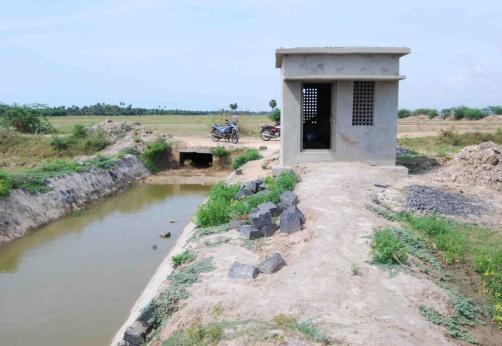Case-study /
Harvesting rainwater through irrigation pond and channels – New water sources for the local agriculture in the village of Motumala, India


Motumala’s water channel
The village of Motumala, which with its approx. 4,200 inhabitants lies 2 km from the coast of the Bay of Bengal in Andhra Pradesh. The community’s agricultural output, which is also the main source of income has declined due to droughts and shorter intense rainfall, which now even occur during dry season. Water became scarce while the demand for irrigation water was rising. A 600 acre government-built irrigation tank, built for 14 villages in the region had just enough water to irrigate the cultivated fields for a few months during dry season. However, it had more capacity, but during the rainy season water goes to waste by running through a drainage canal, past the tank and into the sea. Such changing rainfall patterns and a projected increase in heavy precipitation events, which are aggravated by climate change, are going to put the local water resources under even greater pressure.
With the help of the EU-financed AdaptCap project, the community of Motumala decided to attend to their water scarcity by digging a pond in the irrigation canal to capture the excess rainwater. The excavated earth was used to create a check dam acting as water storage area. Rainwater is harvested in the pond and pumped to the irrigation tank for storage and critical use by using two pumps of 12.5 HP (horse power) capacity. The additional water can be used to irrigate 200 acres of land as well as watering an additional 400 acres of fields during times critical to paddy cultivation. The pond as well as the check dam in the canal created 4,000 cubic feet of water storage area from which many thousands of cubic meters of water can be pumped to the tank through a 200 m long pipeline laid with 12 inch diameter pipes. It helps protect standing crops during droughts and erratic monsoons, controlling fields from being flooded and crop from being submerged by water. Every year, an estimated 151,200 m3 of flood water as well as all excess water is pumped into the tank. The scheme utilizes the excess drainage water released into the canal by the side farmers and thus increases water reuse and efficiency. This measure helps over 200 families in the area to safeguard their livelihoods by being able to achieve higher yields now. This adaptation measure’s key benefits are:
- Increase rainwater storage capacity: The capacities to store rainwater were increased by 151,200 m3 per year.
- Increase irrigation acreage: The irrigation channels make it possible to irrigate an additional 400 acres of land for paddy cultivation.
- Ensure water availability: Water for irrigation is now available for a total of 200 acres of tail-end lands.
- Increase crop yield: The annual crop yield increased by 140 tons through the adaptation measure.
Implementation costs
The overall costs of this adaptation measure – including a local vulnerability and needs assessment, capacity building measures in the community, technical support as well as material and labour costs – amounted to Rs. 649,582. Of these, Rs. 549,582 were borne by AdaptCap while the community contributed Rs. 100,000.
Operation & maintenance of the system
In order to remain operative in the long run, several parts of the system require regular operation and maintenance (O&M). Regular O&M activities include:
- Desiltation of pond
- Arresting the leakages along the pipeline
- Servicing motors and pump sets
- Payment of Electricity bill
- Repairs to pump house
The community has taken the on the responsibility for the O&M activities They plan all O&M activities that need to be implemented, yet the local Panchayat and the Irrigation Department are also involved. The average monthly O&M costs amount to Rs. 6,500.
M&E of activities and benefits
A monitoring and evaluation (M&E) system was developed to regularly screen and assess the adaptation project’s sustainability and impact. Information is collected in four areas:
- Effectively achieved vulnerability reduction
- Acceptance by and technical feasibility for the community
- Cost for implementation and regular O&M
- Positive and negative side effects (i.e., environmental, social, economic)
Challenges and lessons learnt
- Ensure a strong buy-in by the community and local authorities for the measure to achieve efficient and sustainable implementation.
- Plan the works for laying the pipelines in the fields after the harvest has finished
- Community participation should be ensured throughout all phases of such an initiative.
- Ensure construction works take place outside of the rainy season and design the time schedule accordingly as rains and cyclones may obstruct and even damage the ongoing works. The construction works for this measure were delayed because as the work site was flooded.
Project background and partners
The project “AdaptCap – Strengthening Adaptation Capacities and Minimizing Risks of Vulnerable Coastal Communities in India” financed by the European Commission has set out to strengthen the adaptation capacities of vulnerable coastal communities in Andhra Pradesh and Tamil Nadu (India) and minimize their climate change-related risks using an integrated approach.
The three-year initiative is implemented by the Indo-German Environment Partnership Programme of Deutsche Gesellschaft für Internationale Zusammenarbeit (GIZ-IGEP) in partnership with four Indian and international partners.
GIZ-IGEP is responsible for the overall implementation and project management.
Academy of Gandhian Studies (AGS) supports the stakeholders in three cities and nine villages in Andhra Pradesh as a local partner, providing training and implementation support in assessing adaptation needs and developing and carrying out adaptation measures.
AVVAI Village Welfare Society (AVVAI) fulfils the same role in Tamil Nadu.
adelphi contributed to developing technology solutions for the pilot projects and M&E frameworks, designing and implementing capacity building programmes and providing technical support for pilot project implementation.
ICLEI South Asia led the implementation of activities in the six urban areas targeted by AdaptCap.
